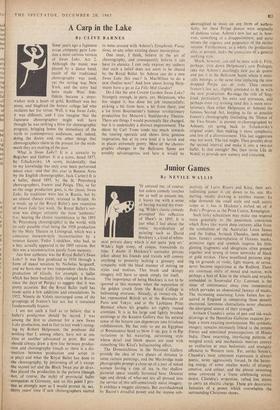Junior Games
By NEVILE WALLIS
The importance of being Hockney is not to be ignored at this moment when the reputation of the golden youth from the Royal College is ballooning overseas. Already, at twenty-six, he has represented British art at the Biennales of Paris and Tokyo, and at the Ljubljana Print Biennial where his graphic art rightly roused attention. It is in his large and lightly brushed paintings at the Kasmin Gallery that his natural sense of the bizarre can degenerate into frivolous exhibitionism. He has only to see an Egyptian or Renaissance head to. blow it up, guy it in flip variations in his wavering, cartooning style whose detail and blank spaces are used with something like Kitaj's hallucinating effect.
The Domenichinos in the National Gallery provide the idea of two planes of distance in some curtain paintings, and the Maybridge nude photographs prompt a close-up of a pair of naked women having a cup of tea in the' shallow pictorial space usually favoured here. Oriental tags and shreds of what-not are all pressed into the service of, this self-consciously naïve imagery. It exhibits a magpie alertness. But overshadowed by Bacon's dreadful power and the intense sub- jectivity of Larry Rivers and Kitaj, their atti- tudinising junior is cut down to his size. His darting, needly drawing is another matter. Its edge demands the small scale and such satiric scope as it has in Hockney's etched set of A Rake's Progress at. the Print Centre, Kensington.
Such larky eclecticism may make one respond more gratefully to the passionate conviction which flows like warm deep currents alike from the symbolism of the Australian Louis James and the Indian Avinash Chandra, both settled here. James's contemplation of Oceanic masks, primitive signs and symbols inspires his little glinting fragments and ideograms often pressed together and strung in loose networks of black or gold strokes. These tessellated patterns sing- ing on grounds of violet, light mauve, or cerise, never become repetitious at the Redfern. There are continual shifts of mood and motive, with perhaps a hint of Klee in the wheels and wraiths embedded in Suspended City. Constant is the Sense of continuance since • time immemorial which pervades an obsessional fantasy of masks. The increasing assurance Louis James has ac- quired in England in composing these densely encrusted, luminous abstractions never obscures the aboriginal source of their strength.
Avinash Chandra's series of pen and ink-wash drawings at the Hamilton Galleries requires per- haps a more exacting reorientation. His symbolic imagery remains intimately linked to the temple friezes and emotional preoccupations of Hindu India. These swarming, interlacing patterns of mingled erotic and mechanistic motives convey an exaltation at once hedonistic and strangely offensive to Western taste. Yet, unlike Souza's, Chandra's most vehement expression is always Poetic, never aggressively forced. In the haunt- ing energy of some smaller works of strongly emotive, acid colour, and the almost swooning sense conveyed in a frieze celebrating sexual desire, Chandra's serpentine, tufted line seems to carry an electric charge. These are decorative fantasies of a power which overwhelms the surrounding Christmas shows.






























 Previous page
Previous page